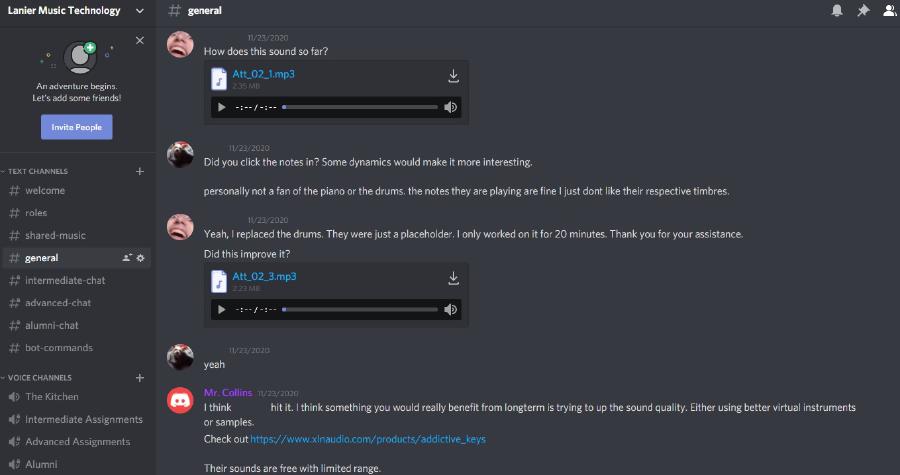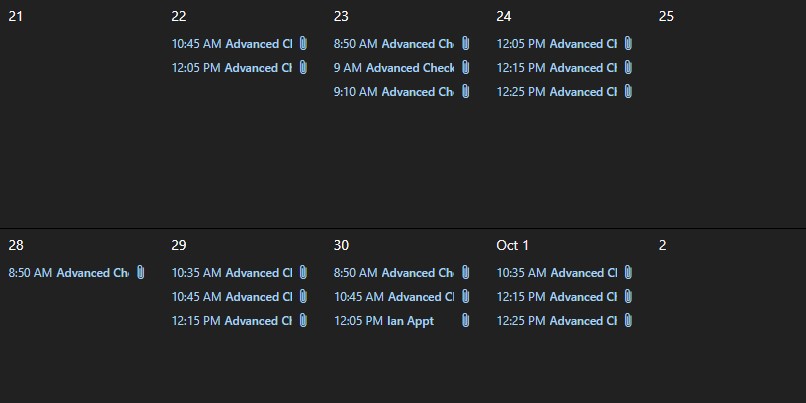
Dynamic Communication
The ability to communicate clearly and effectively is essential for the successful implementation of personalized learning. Educators and learners need to be able to communicate in a variety of ways so that they can continuously exchange information, improve their processes, and advocate for their own needs.
Communicating Advocacy
There is a significant amount of ambiguity when working in the professional world. As a result, its important that learners develop their ability to advocate for both their professional and personal needs. The following are some strategies that I use to help learners become more comfortable advocating for themselves.
Discord

A natural part of the creative process is getting the opinions of peers and bouncing ideas off of them. When COVID pushed instruction online, this physical interaction almost evaporated entirely since I had no mechanism to facilitate it with a virtual format in a meaningful way. Classes started again in August with half of the learners online and the other half in person, so I knew that this was an aspect of my learning environment that I had to find a solution for.
It was at this point that a couple of learners approached me about creating a group chat. As a learner, this was something that I had been a part of before and really appreciated. Group chats allow for dynamic communication with asking anything from peer feedback to a different explanation of the assignment.
Soon after the learners approached me, they had started a Discord server themselves specifically for our course which displayed each student’s level (Intermediate, Advanced, or Mastery) with a label and color. The rules that they established were that anyone was welcome to share projects they are working on, ask questions, or just enjoy each other’s company. When the communication drifted too far from professional, they would discuss what an appropriate professional interaction (even if casual) would and should look like.
Desk Song
Looking for a collaborative place to work rather than the main room, a couple of students started working on the floor of one of the lab’s side rooms. They were initially fine with their set-up, but soon after collected some empty boxes and began assembling a workstation. While this worked at the start, the set-up became uncomfortable so they started figuring out a way that they could get a real desk to work on.
The approached me to ask if I had a desk that they could use in the side room, but I did not have one. They began to problem solve going to thrift stores to find a desk, but I told them it wouldn’t be possible without any funds. I then got the idea that they should write a song to ask our principal for a desk (or the funds for a desk). Knowing how supportive he had been thus far, I knew that if the students made a project with a particular purpose in mind (and it was good), he would be more than happy to help out. Thus, Desk Song (above) was created as a way for the students to communicate their needs to the principal.
Guest Speakers

The number one question that learners have when they walk into my music technology course is “what is music technology?”
“Music Technology” is a pretty vague term that can serve as a catch-all for a wide variety of careers. Learners in music technology could be anything from an audio engineer to film score composers or podcasters to foley artists. It is an important part of the curriculum to explore all of these options. When a learner has a particular career that interests them (such as the ones interested in electrical engineering or video game music), I make it a point to invite guests from those fields so that learners can talk with them. Often times, I am able to find these guests from our local community.
Prior to the guest coming, learners receive an overview of the guest and are tasks with preparing a few questions for them. For the learners that are particularly interested in the field, we discuss networking and ensure that they have time to talk with the guest so that they can build the skill of networking and cultivating relationships.
Communicating Curricula
Learners are constantly consuming new information and this makes it hard to keep everything straight. The following are some strategies that I use to help learners stay on top of their assignments.
Weekly Module and Agenda

In a typical learning environment, it is easy for learners to let their mind wander aimlessly and still manage to get all of their work done. The educator serves as their mental safety net recognizing that they are off task and redirecting them. For learners that have transitioned online, the story is different.
This change forces a massive mental shift for many learners as they are now bear the entire responsibility for keeping themselves on tasks and using their time wisely. To help aid learners with this problem, I break up each week of curriculum into its own module within our learning management system. Each module includes an agenda of what we are doing or talking about, important links (such as our Zoom meeting), and any assignments that need to be completed.
Due Dates/Calendar

Similar to how it can be hard to maintain focus and stay on tasks, it can be equally as difficult for learners to keep up with assignments when learning virtually. Learning management systems get plastered with links to content: read this, watch that, use this tool, try this exercise, and complete this assignment. Multiply this by six or seven classes and it becomes easy to see how learners might become lost or overwhelmed by everything.
In an effort solve this problem, I ensure that all of my assignments have a defined due date in the learning management system and in our online gradebook. A feature of these tools is that they create to-do lists for the learner which helps focus their attention. As a bonus, these tools also provide a composite calendar which includes the assignments from all their classes that they can utilize to stay on target.
Additional Resources

Sometimes students just don’t connect with a certain way of explaining things. This could just be how a particular resource/tool/example approaches the topic at hand. In an effort to personalize their learning, I include links to multiple different resources on every topic we discuss. This allows the students to not be stuck with a one-size-fits-all approach and find the tool that works best for them. With every set of links for additional resources, I include a video in which I provide an overview of each resource so that the students can have an idea of what might work best for them before they start exploring.
Communicating Strategies
Communication includes more than learning materials - it also includes keeping stakeholders informed. The following are some strategies that I use to better communicate with learners, parents and colleagues, and the community as a whole.
Co-Planning

Being able to communicate with others in a variety of contexts is an important skill for 21st-century learners. In the workforce, they will be a part of teams that are dynamic which will require them to quickly build relationships, network, and facilitate conversations. To help develop this skill, I have started to implement co-planning sessions with my third-year and fourth-year learners.
Each of these learners have their own highly individualized capstone project, which means it is next to impossible for me to remember all of the nuance of their project. The beauty of the co-planning sessions is that it forces them to update me on their progress with a high-level of details and then seek clarity on aspects of the project they are stuck on. Their success depends on how well the can facilitate the conversation and clearly communicate their week-to-week progress. I develop this skill by starting with larger questions to help guide them to providing enough detail. As they progress through their project, this slowly shifts to them leading the entire conversation. Not only are they learning how to lead a professional conversation with a supervisor, but it also helps build our educator-learner relationship.
Praise Email

Often parents and other educators only receive an email about a learner when the learner has done something wrong. It is easy for humans to spot mistakes and highlight them – it’s a survival mechanism. Unfortunately, this makes the educator always the bearer of bad news which reinforces a negative relationship with those being receiving the communication. Being aware of this, I try to make sure that I am sending a variety of emails out with a focus on neutral or positive emails over negative. Not only does this foster a positive relationship with those receiving communication, but it also adds weight when they do receive the rare, negative email. Praise emails can range from celebrating a learner’s success to sharing their works or indicating that the exhibited a desired behavior.
Social Media
Kendall Finley was one of twelve students in the State of Georgia to have their music creations selected and showcased at a recording studio in Athens, GA during the state music educators' conference. Feel free to listen to her piece at https://t.co/Siwae6RHeK. pic.twitter.com/imKvhBBmuH
— Lanier High School GA (@lanierhsga) February 10, 2020
One of the largest yet most often neglected stakeholders for the school are the businesses, organizations, and other members of the community which may not have a direct connection to a learner but might have a vested interest in the success of a school. These stakeholders often receive sponsorship requests from school activities, but educators rarely reach out to them for guest speakers, assistance with a project, or to share learner excellence. In an effort to help foster and nurture the relationship with our community, I try to share as much as possible. This includes showcasing guests that come to speak, stellar learner projects and accomplishments, and any fun projects. A couple of examples include a top-tier music producer that visited thanks to a community member, student accolades, and a larger project to be shared with our cluster elementary and middle schools.
Damon Thomas is a music producer, who has shared the workplace with the countless A-class recording artists. He is imparting his wisdoms and experience with the LHS Music Tech students! #hookemhorns pic.twitter.com/poHDT0BAJR
— Lanier High School GA (@lanierhsga) September 19, 2019
References
Ice, P., Curtis, R., Phillips, P., & Wells, J. (2007). Using Asynchronous Audio Feedback to Enhance Teaching Presence and Students’ Sense of Community. Journal of Asynchronous Learning Networks, 11(2), 3-25. https://files.eric.ed.gov/fulltext/EJ842694.pdf
RMC Research Corporation. (2009) Engaging Stakeholders. Sustaining Reading First, 16(6). https://www2.ed.gov/programs/readingfirst/support/stakeholderlores.pdf
Rymanowicz, K. (2018, November 1). Teaching children to be their own self-advocate. Michigan State University. https://www.canr.msu.edu/news/teaching-children-to-be-their-own-self-advocate
Schellenberg, K. (2015, June 12). Teaching Advocacy in Your Classroom. Edutopia. https://www.edutopia.org/discussion/teaching-advocacy-your-classroom
Stachowiak, B. (2018, May 16). Communicating Across The Curriculum. Teaching In Higher Ed. https://teachinginhighered.com/2018/05/16/communicating-across-the-curriculum-reflections/